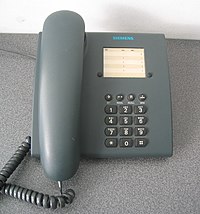Landline

A landline, main line or fixed-line is a telephone line which travels through a solid medium, either metal wire or optical fibre. This is distinguished from a mobile cellular line, where the medium used is the airwaves. Landlines usually cost less than cellular lines and provide better voice quality, and are used when there is no need for mobility or where cellular service is unavailable. A land line is also used to increase the security of communications, as it cannot be intercepted by a receiver without physical access to the line. (This does not, however, mean that a telephone company will not send the call over the air on some point in the journey.)
In 2003, the CIA reported approximately 1263 million main telephone lines worldwide. China had more than any other country, at 350 million, and the United States was second with 268 million - this compared with 219.4 million cellular telephones, a number which is expected to exceed the landline number within a few years.
Fixed phone
A fixed phone line (that is, a not mobile phone line) can be hard-wired or wireless.
Fixed wireless refers to the operation of wireless devices or systems in fixed locations such as homes and offices. Fixed wireless devices usually derive their electrical power from the utility mains electricity, unlike mobile wireless or portable wireless which tend to be battery-powered. Although mobile and portable systems can be used in fixed locations, efficiency and bandwidth are compromised compared with fixed systems. Mobile or portable, battery-powered wireless systems can serve as emergency backups for fixed systems in case of a power blackout or natural disaster.
The technology for wireless connection to the Internet is as old as the Net itself. Amateur radio operators began "patching" into telephone lines with fixed, mobile, and portable two-way voice radios in the middle of the 20th Century. A wireless modem works something like an amateur-radio "phone patch," except faster. High-end fixed wireless employs broadband modems that bypass the telephone system and offer Internet access hundreds of times faster than twisted-pair hard-wired connections or cell-phone modems.
Dedicated lines
The term landline is also used to describe a connection between two or more points that consists of a dedicated physical cable, as opposed to an always-available private link that is actually implemented as a circuit in a wider switched system (usually the public switched telephone network). So-called leased lines are invariably of the latter type; the implication of a landline in this context is one of security and especially of survivability. For example, a military headquarters might be linked to front-line units "by landline" to ensure that communication remains possible even if the conventional telephone network is damaged or destroyed. This was the case in the Second World War, in which the RAF Fighter Command had its radar stations and aerodromes connected to headquarters by land lines; its more mobile opponent, the German Luftwaffe, used radio - and so its commands were deciphered by the British (see Ultra).
This usage is (obviously) much older than the use of "landline" to indicate a non-mobile telephone, and older than its similar use in CB slang. Engineers and other telecommunications experts have at times seen the more popular use as a misuse of the word. As a consequence, in professional contexts "fixed line" or "wireline" are more commonly used words than "landline", although even in these contexts the use is becoming more common and "landline" will likely be the dominant word before too long .
